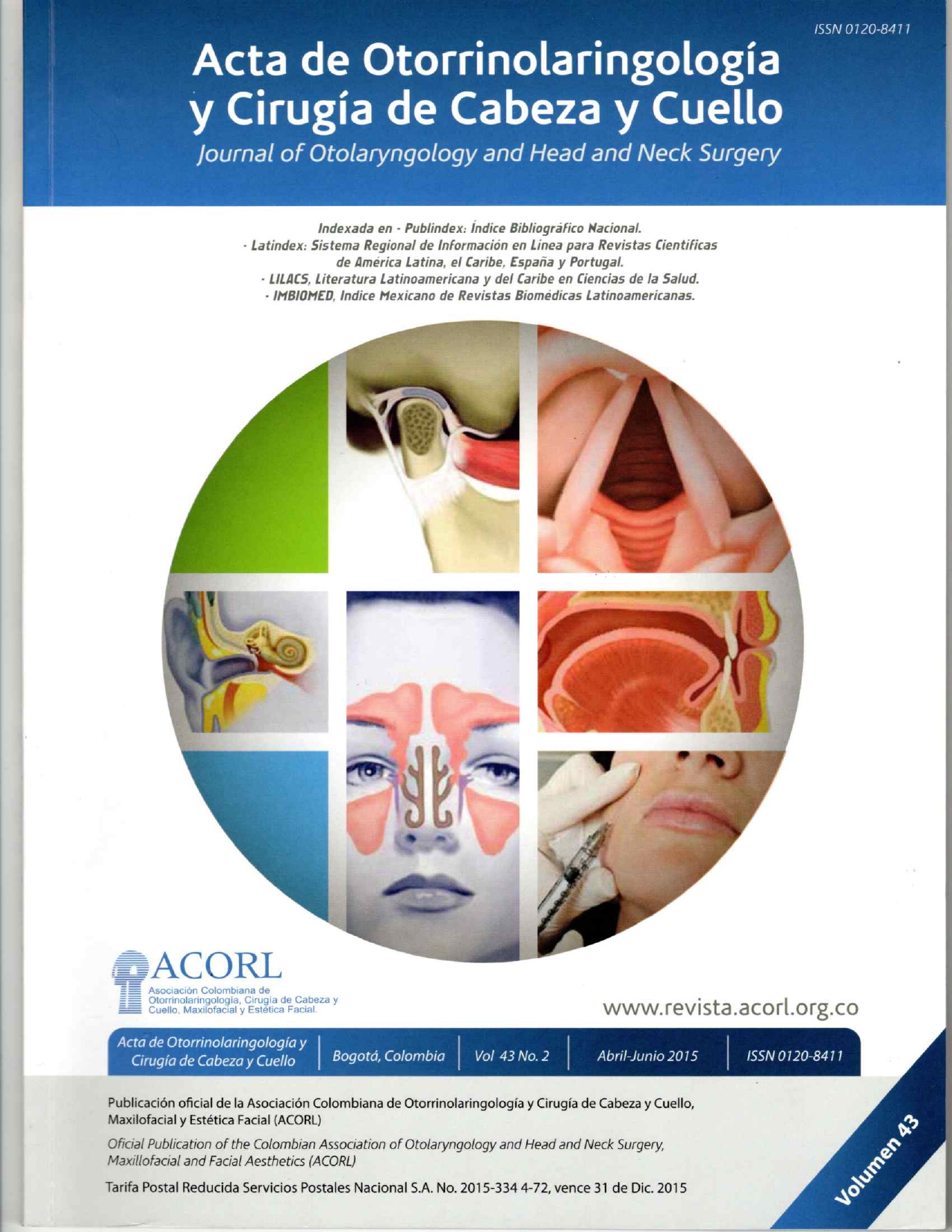Uso de tetradecil sulfato de sodio aplicado submucoso en paladar blando como tratamiento del SAOS leve
Contenido principal del artículo
Resumen
Introducción: El Síndrome de Apnea Obstructiva del Sueño (SAOS) es uno de los trastornos de sueño más frecuentes, asociada con el riesgo cardiovascular. En la actualidad se ha descrito el uso de esclerosantes en el manejo del ronquido simple, no en la apnea del sueño leve. Objetivo: Evaluar la eficacia de este procedimiento para los pacientes con SAOS de intensidad leve con sitio exclusivo de obstrucción en paladar blando. Diseño: Estudio cuasi-experimental no controlado de antes y después. Métodos: Se incluyeron 11 pacientes con SAOS leve, con sitio de obstrucción exclusivo en paladar blando. Se realizó polisomnografía basal y de control a los 6 meses del tratamiento. Se usó tetradecil sulfato de sodio 3%, submucoso en paladar blando 1ml. en la línea media y 0.5 ml paramedial. Se evaluó el índice de ronquido, de apnea/hipopnea (IAH), saturación de oxígeno y despertares. Discusión: Aunque
el número de pacientes es muy pequeño, este es el único antecedente del uso de esclerosantes en el tratamiento de apnea del sueño leve, siendo un procedimiento rápido, económico y poco molesto. Se observó mejoría en los parámetros evaluados exceptuando los despertares. Conclusiones: La inyección de esclerosantes podría ser un tratamiento de elección en pacientes con SAOS leve que cumplan con los criterios de obstrucción ya nombrados.
Detalles del artículo
Sección

Esta obra está bajo una licencia internacional Creative Commons Atribución-CompartirIgual 4.0.
Este artículo es publicado por la Revista Acta de Otorrinolaringología & Cirugía de Cabeza y Cuello.
Este es un artículo de acceso abierto, distribuido bajo los términos de la LicenciaCreativeCommons Atribución-CompartirIgual 4.0 Internacional.( http://creativecommons.org/licenses/by-sa/4.0/), que permite el uso no comercial, distribución y reproducción en cualquier medio, siempre que la obra original sea debidamente citada.
eISSN: 2539-0856
ISSN: 0120-8411
Cómo citar
Referencias
Bonsignore MR, Zito A. Metabolic effects of the obstructive sleep apnea syndrome and cardiovascular risk. Arch Physiol Biochem. 2008; 114(4): 255-60.
Zamarrón C, Valdés Cuadrado L, Alvarez-Sala R. Pathophysiologic mechanisms of cardiovascular disease in obstructive sleep apnea syndrome. Pulm Med [Internet] 2013 [Consultado 2014 Feb 15]; 2013: 521087. Disponible en: http://www.ncbi.nlm.nih.gov/pmc/articles/PMC3712227/
Vgontzas AN. Does obesity play a major role in the pathogenesis of sleep apnoea and its associated manifestations via inflammation, visceral adiposity, and insulin resistance? Arch Physiol Biochem. 2008; 114(4): 211-23.
Brietzke SE, Katz ES, Roberson DW. Can history and physical examination reliably diagnose pediatric obstructive sleep apnea/hypopnea syndrome? A systematic review of the literature. Otolaryngol Head Neck Surg. 2004; 131(6): 827-32.
Schwengel DA, Dalesio NM, Stierer TL. Pediatric Obstructive Sleep Apnea. Anesthesiol Clin. 2014; 32(1): 237-61.
Borges JG, Ginani GE, Hachul H, Cintra FD, Tufik S, Pompéia S. Executive functioning in obstructive sleep apnea syndrome patients without comorbidities: focus on the fractionation of executive functions. J Clin Exp Neuropsychol. 2013; 35(10):1094-107.
Lal C, Strange C, Bachman D. Neurocognitive impairment in obstructive sleep apnea. Chest. 2012; 141(6): 1601-10
Kiratli PO, Demir AU, Volkan-Salanci B, Demir B, Sahin A. Cerebral blood flow and cognitive function in obstructive sleep apnea síndrome. Hell J Nucl Med. 2010; 13(2): 138-43.
Ozdemir C, Conkbay?r I, Kuru A, F?rat H, Sökücü SN, Dalar L, et al. Correlation between the intima-media thickness and Framingham risk score in patients with sleep apnea syndrome. J Thorac Dis. 2013; 5(6): 751-7.
Xie X, Pan L, Ren D, Du C, Guo Y. Effects of continuous positive airway pressure therapy on systemic inflammation in obstructive sleep apnea: a meta-analysis. Sleep Med. 2013; 14(11): 1139-50.
Peter JV, Moran JL, Phillips-Hughes J, Graham P, Bersten AD. Effect of non-invasive positive pressure ventilation (NIPPV) on mortality in patients with acute cardiogenic pulmonary oedema: a meta-analysis. Lancet. 2006; 367(9517):1155-63.
Kendzerska T, Gershon AS, Hawker G, Leung RS, Tomlinson G. Obstructive sleep apnea and risk of cardiovascular events and all-cause mortality: a decade-long historical cohort study. PLoS Med. 2014 Feb 4; 11(2):e1001599.
Vrints H, Shivalkar B, Hilde H, Vanderveken OM, Hamans E, Van de Heyning P, et al. Cardiovascular mechanisms and consequences of obstructive sleep apnoea. Acta Clin Belg. 2013; 68(3): 169-78.
Friedman M, Soans R, Joseph N, Kakodkar S, Friedman J. The effect of multilevel upper airway surgery on continuous positive airway pressure therapy in obstructive sleep apnea/ hypopnea syndrome. Laryngoscope. 2009; 119(1): 193-6.
O’Connor-Reina C, Garcia-Iriarte MT, Gomez Angel D, Rodríguez-Diaz A. Bipolar radiofrequency uvulopalatoplasty combined with injection snoreplasty: a reasonable option for the problem of snoring. ORL J Otorhinolaryngol Relat Spec. 2009; 71(2): 105-11.
Al-Jassim AH, Lesser TH. Single dose injection snoreplasty: investigation or treatment? J Laryngol Otol. 2008; 122(11): 1190-3.
Lin HC, Friedman M, Chang HW, Gurpinar B. The efficacy of multilevel surgery of the upper airway in adults with obstructive sleep apnea/hypopnea syndrome. Laryngoscope. 2008; 118(5): 902-8.
Iseri M, Balcioglu O. Radiofrequency versus injection snoreplasty in simple snoring. Otolaryngol Head Neck Surg. 2005; 133(2): 224-8.
Brietzke SE, Mair EA. Injection snoreplasty: investigation of alternative sclerotherapy agents. Otolaryngol Head Neck Surg. 2004; 130(1): 47-57.
Brietzke SE, Mair EA. Injection snoreplasty: extended followup and new objective data. Otolaryngol Head Neck Surg. 2003; 128(5): 605-15.
Brietzke SE, Mair EA. Injection snoreplasty: how to treat snoring without all the pain and expense. Otolaryngol Head Neck Surg. 2001; 124(5): 503-10
Se encuentra publicado en la siguiente revista: Hindawi Publishing Corporation Sleep Disorders Volume 2012, Article
ID 597684, 4 pages doi:10.1155/2012/597684





